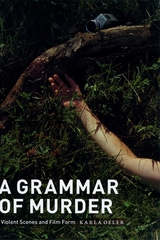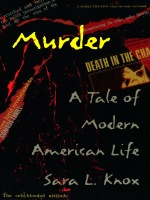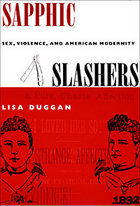
The dark shadows and offscreen space that force us to imagine violence we cannot see. The real slaughter of animals spliced with the fictional killing of men. The missing countershot from the murder victim’s point of view. Such images, or absent images, Karla Oeler contends, distill how the murder scene challenges and changes film.
Reexamining works by such filmmakers as Renoir, Hitchcock, Kubrick, Jarmusch, and Eisenstein, Oeler traces the murder scene’s intricate connections to the great breakthroughs in the theory and practice of montage and the formulation of the rules and syntax of Hollywood genre. She argues that murder plays such a central role in film because it mirrors, on multiple levels, the act of cinematic representation. Death and murder at once eradicate life and call attention to its former existence, just as cinema conveys both the reality and the absence of the objects it depicts. But murder shares with cinema not only this interplay between presence and absence, movement and stillness: unlike death, killing entails the deliberate reduction of a singular subject to a disposable object. Like cinema, it involves a crucial choice about what to cut and what to keep.

In her approach to the telling of this cultural phenomenon, Knox draws on historical analysis and original research. She discusses such subjects as the continuing existence of capital punishment, the “sensational” American murderers Martha Beck and Ray Fernandez (aka the Honeymoon Killers), the connection between true crime books and romance narratives, and pulp murder novels of the 1930s and 1940s. Analyzing widespread interest in forensic psychiatry, sexuality, mortality, and the relation of gender to society’s reactions to murder, Knox refers to the early work of David Brion Davis, Bill Ellis, and Joel Black. While demonstrating how society’s focus has shifted from the act itself to the psychology of the murderer to the broader social forces at work, she discusses the writings of Willard Motley, William March, Curtis Bok, James Baldwin, and Kate Millett, among others.
Full of anecdotes and insights, Murder is a lively meditation on American culture that includes not only close critical readings of individual texts but also everyday matters of murder’s meaning. It will interest those involved with American studies, cultural studies, and true crime accounts.

This book is about murder—in life and in art—and about how we look at it and feel about it. At the center of Wendy Lesser’s investigation is a groundbreaking legal case in which a federal court judge was asked to decide whether a gas chamber execution would be broadcast on public television. Our grim and seemingly endless fascination with murder gets its day in court as Lesser conducts us through the proceedings, pausing along the way to reflect on the circumstances of violent death in our culture. Her book, itself a murder mystery of sorts, circling suspensefully around a central point, is also a meditation on murder in a civilized society—what we make of it in law, morality, and art.
Lesser narrates the trial with a sharp eye for detail and an absorbing sense of character. Questions that arise in the courtroom conjure other, broader ones: why are we drawn to murder, as an act and as a spectacle? Who in a murder story are we drawn to—victim, murderer, detective? Is such interest, even pleasure, morally suspect? Lesser’s reflections on these questions follow the culture in its danse macabre, from Norman Mailer’s Executioner’s Song to the Jacobean play The Changeling, from Errol Morris’s documentary The Thin Blue Line to Crime and Punishment, from Janet Malcolm’s The Journalist and the Murderer to Jim Thompson’s The Killer Inside Me, from Weegee’s photographs to television’s movie of the week. Always anchored in the courtroom, where the question of murder as theater is being settled in immediate, human terms, this circle of thought widens outward to the increasingly blurred borderline between real and fictional murder, between event and story, between murder as news and as art. As gripping as its subject, Pictures at an Execution ultimately brings us face to face with our own most disturbing cultural impulses.

Situating this story alongside simultaneously circulating lynching narratives (and its resistant versions, such as those of Memphis antilynching activist Ida B. Wells) Duggan reveals how stories of sex and violence were crucial to the development of American modernity. While careful to point out the differences between the public reigns of terror that led to many lynchings and the rarer instances of the murder of one woman by another privately motivated woman, Duggan asserts that dominant versions of both sets of stories contributed to the marginalization of African Americans and women while solidifying a distinctly white, male, heterosexual form of American citizenship. Having explored the role of turn-of-the-century print media—and in particular their tendency toward sensationalism—Duggan moves next to a review of sexology literature and to novels, most notably Radclyffe Hall’s The Well of Loneliness. Sapphic Slashers concludes with two appendices, one of which presents a detailed summary of Ward’s murder, the trial, and Mitchell’s eventual institutionalization. The other presents transcriptions of letters exchanged between the two women prior to the crime.
Combining cultural history, feminist and queer theory, narrative analysis, and compelling storytelling, Sapphic Slashers provides the first history of the emergence of the lesbian in twentieth-century mass culture.
READERS
Browse our collection.
PUBLISHERS
See BiblioVault's publisher services.
STUDENT SERVICES
Files for college accessibility offices.
UChicago Accessibility Resources
home | accessibility | search | about | contact us
BiblioVault ® 2001 - 2024
The University of Chicago Press









